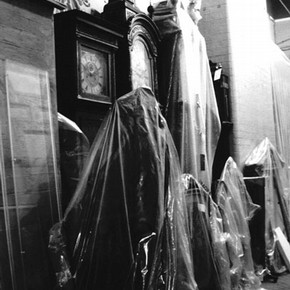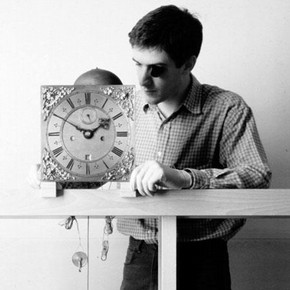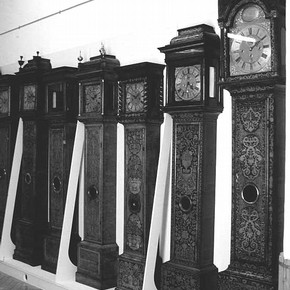Conservation Journal
July 1999 Issue 32
An Improved Storage System for the Clock Collection

Figure 1. A view of one of the former storage locations (Room 58 Store) Photograph by Timothy Hayes (click image for larger version)
An important stage of the Heritage Lottery-funded refurbishment of the British Galleries has recently been completed, with the successful de-installation of the fifteen galleries and eight storage areas that formerly housed the Museum's collection of British Art and Design. A process that engaged the collaborative resources of the entire Museum, during the redistribution of objects from 10% of the Museum's gallery space.
The logistical implications of the storage project had initiated a search for alternative gallery and storage locations, which culminated in the implementation of a high density storage system for the furniture and woodwork collections, accommodated at the museum's principle store Blythe House 1 . This article describes a single component of the storage system, that was specifically designed to accommodate the displaced collection of clocks. Proposals for the new gallery scheme offered few opportunities for the display of horological objects, a position that highlighted a demand for improved access to the stored collections.
Previous storage conditions
The British Art and Design gallery and storage rooms had previously accommodated a diverse selection of clocks, illustrating the stylistic development of casework and clock design. The objects were principally interpreted as examples of cabinet design with an emphasis on decorative casework (e.g. floral marquetry, japanned decoration, figured woods, etc.), rather than on horological innovation.
The majority of clocks were spread throughout a series of storage locations that provided a minimal level of environmental and physical protection. The storage conditions of the longcase clocks offered a particularly low standard of horological storage, with objects standing directly on uneven wood-block floors, grouped in close proximity to each other and concealed underneath polythene sheeting (see figure 1). Access to the collection was somewhat limited due to the restricted storage space, and the generally inhospitable, dusty, poorly lit and overcrowded conditions.
Movement and handling of the objects was unnecessarily time consuming, occasionally hazardous and risked damage to the delicate clock components. Surveys undertaken during the preliminary stages of the British Gallery project had identified the storage conditions as being the primary cause of structural and chemical deterioration of both the wood and metal components.
Comparative review of storage systems
The principle objective was to create a facility that would improve the general standard of long-term storage and provide greater access to the collection; a designated store that would maximise the space available, without compromising the accessibility and safety of the objects 2 .
The Conservation Department does not contain a specialist section for the specific treatment of clocks. Therefore, the initial stages of research to investigate appropriate storage systems was based on communication with external horological sources. A comparative assessment of storage facilities held within other institutions 3 , revealed distinct differences in store form and function. In general, the storage systems conformed to three models:
-
Standard Storeroom: This form of store conformed to the standard museum model, providing a secure storage enclosure that offered a flexible range of environmental parameters for the long-term preservation of mixed material objects. The individual storage requirements for specific clock components were also featured.
-
Study Collection Store: This store functioned as a horological study room, which enabled greater public access to the objects under the supervision of specialist staff. The store displayed objects using a combination of open and closed storage systems, with sections of the collection maintained in an operational condition.
-
Work Room Store: This form of store provided a secure enclosure for the short-term storage of clocks, before and after their restoration to an operational condition. The store incorporated a designated area for testing the restored longcase clock mechanisms, supported on special stands that allowed open access to the mechanism, pendulum and weights.
The review of storage facilities provided the basis for an outline specification that included elements of each of these three storage models.
Blythe House clock store
The storage system had to be installed in the available space within the constraints of the project (floor loading, accessibility, programme, budget), and to meet the Furniture and Woodwork Department's criteria for storage of collection type, chronologically within each type of category, and by nationality - British or Continental 4 . A single storage area was considered the most appropriate solution, which complied with both the general constraints of the project and specific object requirements.
A room was located at Blythe House, within the main furniture store (S11), offering substantial floor (61m²) and wall space, with entry via a large double door. Located in the south-west corner of the building, the room had formerly served as a hoist room allowing access for outside deliveries to the second floor. Windows were arranged along the southern section of wall with the hoist entrance located at the west wall; water pipes serving radiators also ran along the two external walls. Initial concerns regarding the environmental limitations of the room, in terms of extreme and fluctuating levels of relative humidity and temperature, were partly allayed following a climatic assessment of one month durationthat reported mean value parameters of 56% RH and 15°C 5 .
A programme of modifications to the room, consistent with the refurbishment of the main furniture and woodwork stores, included the fitting of insulated blanking panels 6 to the interior facings of the windows and to the hoist door. It is the intention to maintain a lower temperature and improve the air circulation in the store to inhibit the metal components reactivity to any potentially corrosive pollutants.
Storage requirements and installation methodology
The decision to store the objects within the context of a study collection, influenced the planning and design process of the storage facilities and layout. The objects needed to be accessible to visual inspection of both the clock mechanism and decorative casework. A standard methodology for object storage was researched for each of the principle groups of clock. Firstly, the collection was quantified in terms of clock type, with distinct forms of clock grouped into separate storage categories. Each category was then individually assessed to determine the most appropriate method of storage.The assessment criteria considered several factors:
-
Structural Condition of Object
-
Individual Installation Requirements
-
Storage of Clock Parts
-
Accessibility
-
Physical Protection
-
Security
(a) Longcase Clock Storage
This category of clock formed a significant part of the collection and required the largest volume of storage accommodation. A standard longcase clock is composed of several detachable components:
-
The wooden casework comprises a main case (trunk) and a mechanism cover (hood).
-
The metal clock comprises a mechanism (movement), a pendulum and two or three lead weights.
The narrow proportions and height of the case components, combined with the location of the metal mechanism in the upper section of casework, can contribute to an uneven distribution of weight throughout the object. Consequently, longcase clocks require a flat wall surface and level floor, to provide support and a secure point of attachment for the main casework. Historically, long cased clocks were placed directly against a wall and secured with either a nail or screw through the backboard of the casework. A secure and level siting was an important factor for the effective operation of a clock mechanism.
A series of plinths with integral backboards offered the most practical solution to support and secure the clock casework. A system of prefabricated storage units was designed that could be fixed directly against a wall, or placed back-to-back in order to utilise the central floor space 7 . The objects could be classified and arranged into distinct groups (e.g. clocks with marquetry veneered cases), with sufficient space between objects to view the clock mechanism from both the left and right side (see figure 2).
Each clock case was attached to the unit backboard with dome-headed screws passing through the backboard of the casework. Most longcase clock backboards will show evidence of previous fixing holes, which can be reused with the addition of a steel washer to displace the pressure of the screw head. Alternative methods of attachment included the use of existing metal fixing plates.
The clock mechanism is normally attached to a wooden board (seat board), which rests on the top of the case sides (cheeks). The pendulum is fitted to the rear of the mechanism by its suspension spring, passing through the crutch and slotting into the back-cock. Pendulums were stored attached to their respective clocks to act as a counter weight to the dial plate, an insecurely mounted mechanism could tip forward and risk damage to the hood door glass. Clocks that were without their pendulum or that were not securely mounted to the case cheeks, were fixed into position with screws that utilised former nail or screw holes in the seat board. Lead weights were stored separately (see clock component storage).
An examination and testing stand was included in the store design to enable close inspection of the mechanism components (see figure 3), and to provide a secure platform for the testing of longcase clocks. It is planned to have a specific group of clocks restored to an operational condition for inclusion in the future British Galleries.

Figure 3. Mechanism Examination & Testing Stand. Photograph by Timothy Hayes (click image for larger version)
(b) Clock component storage
Unidentified and/or damaged pendulums were stored upright in a rack, designed to support the pendulum bob, secure the rod and protect the delicate suspension spring.The numerous lead clock weights were stored on a high, weight-bearing, shelving system 8 . A sheet of high-density foam was applied to the shelves and the individual weights, arranged on their sides, effectively embedded themselves into the foam 9 . Strips of foam were also fitted between weights as a precaution against abrasion, caused by direct contact between the finer brass sleeved lead weights and the roughcast lead weights.
(c) Spring (Bracket) clock storage
This category of clock could be accommodated with comparative ease into metal storage cabinets 10 . The relatively small dimensions of the objects and their delicate mechanical components demanded a closed system of storage that provided a secure and dust-free environment.
Conclusion
The new storeroom concentrates a substantial collection of the Museum's clocks in an environment that is accessible and conducive to the study and appreciation of both casework and clock design. The unpacking and installation process, is at the time of writing this article still in progress, with further developments of suitable clock component storage being investigated.
Acknowledgements
I would like to thank the following individuals for allowing access to their stored collections: Jonathan Betts (The Old Royal Observatory), Jeremy Evans (The British Museum), Helen Kingsley (The Science Museum), Roger Still (West Dean College). Consultation with horological experts from outside the Museum was a key factor during the development, planning and installation stages of the project. During the installation process Christopher Powell, a third year student from West Dean College, undertook a short internship that studied the condition of the clock mechanisms, carried out remedial corrections and advised on installation procedures.
References
1. The merits of the high density storage system have been reported in other publications: Hershberg, S., King, S., and Ward, A., Making the most of storage space, Museum Practice, No.10 (vol.4 No.1) 1999.
2. Hershenberg, S., A Standard for Storage, V&A Discussion Document, 1998.
3. The Old Royal Observatory, the British Museum, the Science Museum, West Dean College.
4. Hershenberg, S., King, S., and Ward, A., ibid
5. Mills, P., Climate Report on the Hoist Room of Blythe House, Science Group Report, No.97/73/PJM
6. Celotex LG2 Insulation Board on softwood framing and sealed with neutral-curing silicone.
7. The longcase clock storage units were constructed from birch veneer plywood and coated with a water-based matt emulsion paint.
8. Strongspan Shelving, Planned Storage Systems Ltd.
9. Plastazote Foam, Polyformes Ltd.
10. Storage Cabinets (Clearview Range) Storage by Design Ltd.
July 1999 Issue 32
- Editorial - A Taste for the New?
- The RCA/V&A Conservation Course: Changes Over Time
- Old Treatment, New Problem: Bakelite as a Consolidant
- An Improved Storage System for the Clock Collection
- Three Dimensional Digital Visualisation: Research in Progress
- Not So New Methods of Cleaning
- So that's why Textile Conservation has such a Big Studio! - Tapesty Washing at the V&A
- Energy Efficient Pollution Control in Museums and Galleries
- Science Surgery
- Printer Friendly Version
